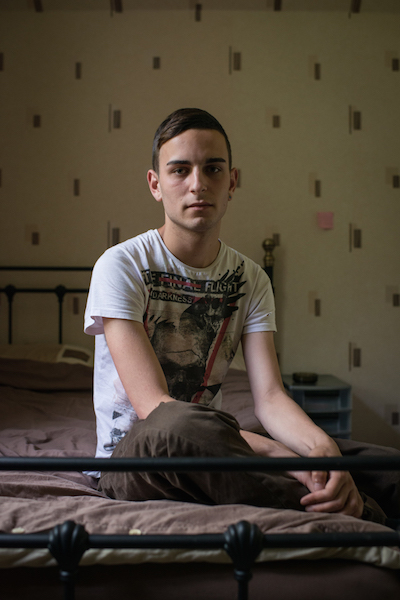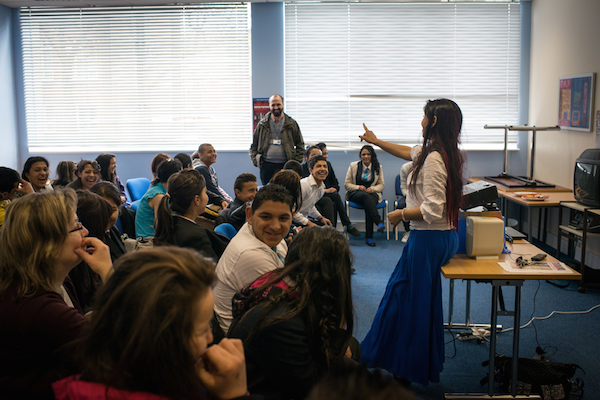
Redeye's Jo Slack speaks to photographer Ciara Leeming about her work with migrant Roma families, and her current exhibition at Salford Art Museum and Gallery.
Jo Slack (JS): Turn Sideways in the Wind is currently on display at Salford Art Museum and Gallery; tell us a bit about the background of the project, and how it came to be displayed there?
Ciara Leeming (CL): I’ve been working with Roma families as a photographer since 2011 and have known each of the three subjects of this exhibition for years now. I first became interested in learning more about Roma culture a few years before I started shooting the work, for several different reasons. I’d already been documenting aspects of British Gypsy and Traveller culture when I realised that my neighbourhood (Levenshulme, Manchester) was home to a growing population of Romanian Roma – who share their roots with British Romani people. I found them fascinating because while on the one hand they were quite visible due to the way they dress, they are so close-knit that they can be difficult to get to know better. Once I found a family to photograph the project took shape and I later got opportunities to document Roma migrants from other EU countries and to learn about their lives.
I am also attracted to the subject precisely because of the overwhelmingly negative press these communities tend to get. These are the kinds of issues I’m drawn to because I want to form my own opinions and get to know people who are frequently marginalised or judged by mainstream society. I love the fact the camera gives me a licence to poke my nose into other people's lives.
The reason why it’s on show in Salford is simply because Salford Museum and Art Gallery have a twice a year application process for exhibitions, and I was lucky to be selected. I felt that since my work has been shot in Greater Manchester, it would be great to get the stories in front of a new local audience.

JS: You’ve been working with Romani people for a number of years, and have so far exhibited at Side and published a book, why did you choose these outputs for your work?
CL: The book “Elvira and Me” was the first output of my Roma photography work and I created this for my MA in documentary photography in 2011. I chose the format of a book because I wanted to try to put one together, but it ended up suiting the way Ramona and I told her story quite well. At first this was simply a self-published Blurb book but the Big Issue in the North Trust then offered to turn this into a print run of 1,000 copies, provided they could use some of them as a tool of education around Roma issues. Around this time I was also selected by Amber/Side Gallery and given a commission to fund the creation of a similar body of work with Roma in the North East of England. I worked with a Czech Roma family who live in Middlesbrough and more than 18 months later this work was exhibited at Side Gallery. I like to use my work in different ways so often also experiment with creating web galleries, written pieces and little multimedia pieces.
JS: When you started the project, did you envisage that you would be working on it as long as you have? What do you have planned next?
CL: I didn’t really plan too far ahead but I knew once I’d done the book with Ramona in late 2011 that I wasn’t done with this subject. That was the point when I really started to feel I was getting somewhere access-wise – perhaps because the family now saw what I was trying to do and understood it a bit more. I was lucky then to receive both an Arts Council grant and the Side Gallery commission to fund further work with Roma families, and it’s just continued from there. The project is resting at this point because I’ve had family commitments which have kept me from shooting anything much over the past 18 months or so, but it’s certainly not finished. I still see some of my Romani participants, and regard them as friends. I can’t see myself ever really moving on from this as a subject because I’m still a little in love with it. I have tried to keep my eyes open for other potential projects and nothing has grabbed me yet. Maybe I'm a one subject kind of photographer...
JS: What has been the most challenging thing about documenting Romani people?
CL: Earning people’s trust has taken time. These are groups who tend to socialise largely within extended families and it takes patience to show them that you are genuinely interested in their lives. It took more than a year of trying before I found my first participant, Ramona, and several times I almost gave up - but eventually she opened the door to this work and I haven't looked back. That is not to say it's been easy - I've had many dark nights of the soul fretting about this project, and each time I have started looking for new families the self-doubt has crept in. My experience has been though that once I have found the right people, they have been some of the most hospitable and welcoming families I’ve ever met. I’ve spent birthdays, Christmases and other celebrations with them, have travelled to Romania and the Czech Republic with collaborators and almost photographed one lady giving birth (the baby came late though, after I'd had to leave Middlesbrough).
JS: When you previously exhibited at Side, you wrote that your subjects 'had full control of their representation in the final show, and all the words are theirs’. Did you apply this to the new work at Salford?
CL: Yes, this is how I approach all my visual work. I selected the images that I thought worked but they were then consulted to make sure they were comfortable with them all. The introductory text was written by me but the caption panels which are displayed for each of the three subjects are entirely their quotes. They all saw and approved all the texts before they were finalised. So far two of the three participants have visited the gallery with me and their response has been really positive.
JS: You’ve been working with Romani people for a number of years; how have attitudes towards Romani people in the UK changed in this time? Have you felt the impact of the recent migrant crisis?
CL: I don’t think they have changed particularly. There’s been a lot of negative, sensationalist media attention about Romani migrants over the past few years so possibly some host communities are now more aware of their Roma neighbours – when they first arrived many were able to assimilate that bit more and hide their origins. The media hype is one thing but I've no doubt that many British people have positive interactions with Romani people every day and think nothing much of it - and that's a healthy thing.
I think that Roma communities have also started to find their place in UK society and to understand the system better, and many are growing in confidence and feel able to be open about who they are. Those who have been here a decade or more have children well established in school and sometimes studying at university, and citizens of all EU countries now have a right to take regular jobs here (until 2014 Romanians and Bulgarians had very limited options, which held many families back a lot).

JS: You are a journalist as well as a photographer, tell us about your background in both. Do you think that your journalism has had an impact on your photographic work?
CL: My photographic work is journalism – it’s made to communicate ideas, not to look pretty on someone’s wall. I want my photographic projects to be well researched and journalistically rigorous. My work with Roma families cannot be separated from its context – it is a reaction to the demonisation and stereotyping of these communities by much of the mainstream media. I want it to point to small personal stories which dispel the kind of myths we are being fed about Roma being nothing more than beggars and feckless scroungers because that is really not my experience in five years of meeting and photographing these families. I am careful to stress though that I am not speaking for all Romani people – these are just the experiences and thoughts of a few people who happen to have Romani origins.
Turn Sideways in the Wind is on display at Salford Museum and Art Gallery until the 24th April 2016.
All images by Ciara Leeming.